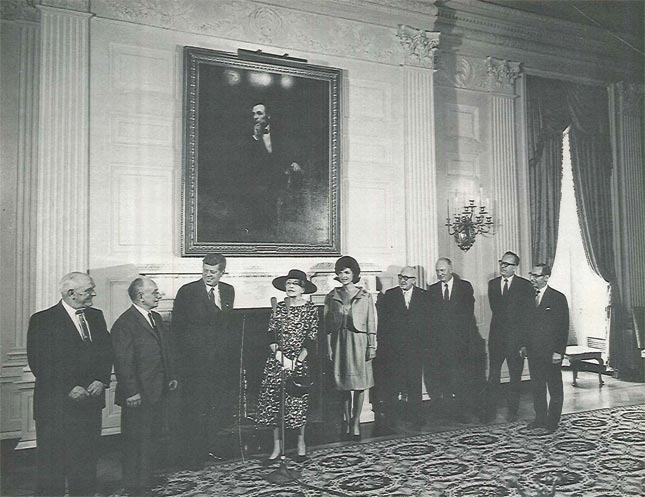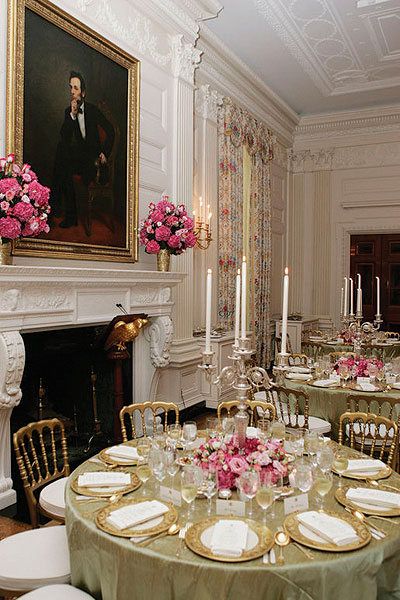Alan Larabee Remembers A Lifetime in Stone
by Liz McGeachy
Photos supplied courtesy Barabara Cohen and White House archives
 ALAN Larabee wasn’t born into the stone industry, he married into it. But it got into his blood just the same. His father-in-law William Koran, a Czechoslovakian stone setter from a long line of stoneworkers, helped him get started in the business when Larabee was only 22 years old. Larabee stayed with the trade for 50 years. Two of his three children also went into the stone industry.
ALAN Larabee wasn’t born into the stone industry, he married into it. But it got into his blood just the same. His father-in-law William Koran, a Czechoslovakian stone setter from a long line of stoneworkers, helped him get started in the business when Larabee was only 22 years old. Larabee stayed with the trade for 50 years. Two of his three children also went into the stone industry.
“My kids always tell me, ‘You’re only a first generation stoneworker because you married into it, but we’re fifth generation,” Larabee said with a laugh.
The stone industry has changed dramatically in the years since Larabee was an apprentice with Miller Druck Company in New York. And he’s happy to illustrate those changes with his stories about work he did at places such as the United Nations Building, where he nearly installed a plaque upside down, to the White House, where he helped build a famous fireplace mantel.
Alan Larabee was born in 1937 and grew up in the Bronx. He left school after 10th grade, and worked in various jobs before going into the Marine Corp. He met his future wife, Lorraine, in 1959 and married her only three weeks later.
“She didn’t think she would make a good military wife,“ Larabee said, “so I tried being a Fuller Brush salesman for a week and that didn’t work, then I tried being a vacuum cleaner salesman, and that really didn’t work. So when my father-in-law said ‘Do you think you’d like to try setting marble?’ I decided to give that a try. The money was good back then. Those were the days when you needed someone with pull to get you into the business.”
Miller Druck Specialty Contracting, Inc. is an international company now, but r said it only had a few employees in the early 1960s when he was learning the trade. “I started out as a ‘go-fer,’ but with only 7-8 people in the entire company, including the front office, it was a tremendous hands-on opportunity to learn everything about the job from master craftsmen.”
Larabee was shown the ropes by a number of stone setters who had emigrated from Czechoslovakia.
“They were always telling me ‘That’s not the way we do it in Praha (Prague),” Larabee complained. But in 1961 when nine stoneworkers in Prague were killed repairing a church damaged during WWII and the New York Daily News ran a big photograph of the tragedy, Larabee cut it out and posted it on the bulletin board at work.
“We didn’t have magic markers back then so I wrote underneath it in crayon, ‘This is the way they do it in Praha,’ and they never said that to me again,” Larabee said. “But I tell you, those guys were all very good to me.”
Larabee explained that there were two stone trade unions in New York at the time, one for the setters, cutters, and carvers and one for the helpers. He started out as a helper and worked his way up to setter with the help of John Danko, who was known as Three-Fingered John.
“He had a flap of skin over two fingers, so he was considered handicapped and not allowed into the military,” Larabee said. “But he was the least handicapped man I knew in the stone industry.”
 Larabee tells the story of working on a project at the United Nations Building with Danko. It was in 1963 when Taiwan was given Observer Status by the UN. Taiwan donated a jade green marble plaque with writing covering it to be placed in the building, and Danko and Larabee were to install it.
Larabee tells the story of working on a project at the United Nations Building with Danko. It was in 1963 when Taiwan was given Observer Status by the UN. Taiwan donated a jade green marble plaque with writing covering it to be placed in the building, and Danko and Larabee were to install it.
Unfortunately they couldn’t tell which way was up, so they had to get an interpreter to help them.
One of the most famous projects Larabee worked on was a reproduction of a fireplace mantelpiece for the State Dining Room in the White House in 1962.
When President Truman left office in 1953, he took the State Dining Room marble mantelpiece with him for the Truman Presidential Library in Missouri. In the early 1960s, when the Dining Room was refurbished, the White House decided to create an exact replica of the Truman fireplace and mantel, which included bison and a prayer: “I pray Heaven to bestow the best of blessings on this House, and all that shall hereafter inhabit it. May none but honest and wise men ever rule under this roof.”
The project was overseen by Malcolm Cohen of Miller Druck Co., who was with the American Marble Industry. Creating the replica meant making a plaster-of-paris model of the original mantel in Missouri, then back in New York, carving the new mantel from a piece of Vermont marble. Larabee remembers that a man named Red Raddy was the carver, and he was his helper.
“I was the assistant – the ‘go-fer,’ the guy who cleaned the floor. I was his Boy Friday,” said Larabee. “Red was all business. I don’t think we exchanged 200 words in the year I helped him, but he knew what he was doing.”
After his early years in the stone industry, Larabee went on to work with the Alberene Soapstone Company in Virginia, which provided stone counters to laboratories around the country. One job, Larabee recalled, involved removing soapstone countertops and replacing them with cast resin tops. The soapstone was placed in storage for future “recycling.”
Alan Larabee is now retired and living in the state of Washington, but he passed his interest in stone onto his two sons. His oldest son, Tom Larabee, works with Alaska Tile in Kenai, Alaska. His younger son, Robert Larabee, died in an automobile accident in 2005, but he was also in the industry.“
The stone industry was a fascinating place to work,” Larabee said. “You were producing something, and you could see the results so clearly.”